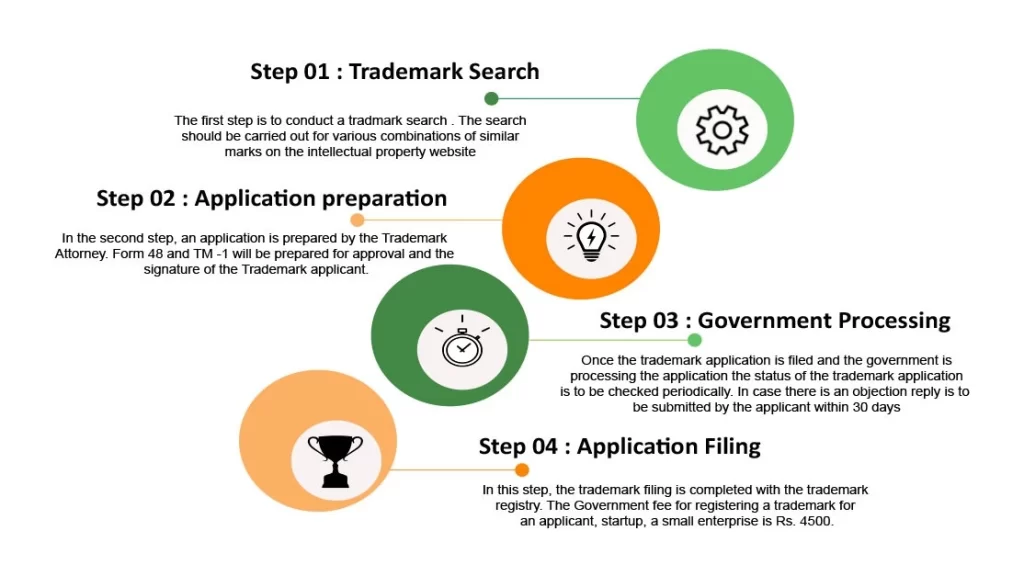Trademark
We can help you draft and file reply to your trademark objection raised by the trademark examiner through our legal experts .

Protect Your brand
Get Yourself Registered
Build your own Brand
Trademark Registration
What is Trademark registration in India?
Trademark registration in India allows the applicant to use symbols or words to represent a business or the products that are offered by a business to distinguish the goods or services that are offered by them from the competitors. After the trademark is registered in India no other organization cannot use it as long as it remains in use.
The “™” symbol can be used with the trademark applicant with the brand once it is registered. Trademark registration is an asset for the company to protect the brand name it is necessary to apply for trademark registration in India. It is always better to obtain the trademark registration under the guidance of an expert as the process has various steps to be followed and also requires regular follow-up from the government.
Filings India has helped thousands of applicants across India to get their trademark registered.

Eligibility for Trademark registration
Who is eligible to obtain trademark registration in India?
Trademark registrations are widely used to protect the brand or slogans or coined words that are unique. Trademark registrations in India can be obtained by individuals or businesses or by non-profit organizations. However, each of the different class of persons or entity that have different requirement while filing the trademark application. The following are eligible for obtaining trademark registration in India.
An individual who is not doing any business can also obtain a trademark application and obtain trademark registration for a symbol or word that is proposed to be used by the applicant in the future.
Joint owners
In case two people are deciding to file a trademark application then the names of both the people must be mentioned on the application.
Proprietorship Firms
While filing a trademark application in India for a proprietorship firm then the full name of the applicant must be mentioned. The business name or the proprietorship is not acceptable.
Partnership firm
When filing a trademark application for the partnership firm the names of all the partners are should be mentioned in the application. If in case the partnership firm includes a minor in the partnership the name of the guardian who is representing the minor should be mentioned.
Limited Liability Partnership
In the case of the Limited Liability Partnership, the application should be in the name of the LLP. An LLP is an incorporated body where the partners have their own identity. The partners cannot be the applicant as the trademark belongs to the LLP.
Indian Company
When it comes to a Private Limited Company and the One person Company or a Public Limited Company making a trademark registration application then the application is to be made in the name of the company. As they are all independent incorporated entities they are applied cannot be made by the Director. Though it can be signed and submitted by the Director or any officer that is authorized by the officer.
Foreign Company
In case is a foreign incorporated entity is making a trademark application in India the application is to be made in the corporate name as it is registered under the foreign country. Here the nature of the registration, the country, and the law is to be mentioned.
Trust or Society
In case if a trademark application is made on the behalf of the trust or the society then the name of the managing trustee or the chairman or the secretary that is representing the trust or the society is to be mentioned.
Types of Trademark registration in India
Various types of trademarks can be registered like product mark, service mark, collective mark, certification mark, shape mark, sound mark, collective mark, certification mark, shape mark, sound mark, and pattern Mark. Though there are many trademarks the purpose for them is the same that is to enable the consumers to identify the goods and the services that are manufactured by certain manufacturers or service providers. Let us take a look at the various types of trademark registrations in India.
Product Mark A product mark is used on a good or a product rather than a service. A product mark helps in recognizing the origin of the product and helps in maintaining the reputation of the business. Trademark applications that are filed under the trademark 1-34 could be termed as product marks as they represent goods.
Service Mark Service Mark is similar to a product mark but the service mark is used to represent a service rather than a product. The main purpose of the service mark is that it helps in distinguishing the proprietors from the owners of other similar services. The trademark applications are filed under the trademark class 35-45 that could be termed as a service mark as they are representing the services.
Collective Mark The collective mark informs the public about the certain distinguishing features of the products and the service that is used to represent a collective. A group of individuals can use this mark so that they are collectively protecting the goods and the services. The mark holder can be an association or it can be a public institution or also a Section 8 Company.
Certification Mark It is a sign that denotes the product’s origin, material, quality, or other specific details which are issued by the proprietor. The main purpose of the certification is to bring the standard of the product and also guarantee the product to the customers by showing that the product has undergone standard tests to ensure quality. Certification marks are usually seen on packed foods, toys, and electronics products.
Shape Mark The shape mark is exclusively used to protect the shape of the product so that the customers find it relatable with a certain manufacturer and prefer to buy the product. The shape of the product can be registered once it is recognized that the product has a noteworthy shape.
Pattern Mark The pattern marks are for those products that have a specified designed pattern that comes out as the distinguishing factor of the product. Patterns that fail to stand out as remarkable marks are rejected. For a pattern mark to be registered it should stand out as unique.
Sound Mark A sound mark is a sound that can be associated with a product or the service that is originating from a certain supplier. Sound logos are also called audio mnemonics and they appear to be at the beginning of the end of the commercial. The most popular sound mark in India is the tune for IPL.
Documents required for Trademark Registration
What are the documents required for obtaining a trademark registration in India?
Trademark registration in India is a process that should be carried out under expert guidance. IndiaFilings has helped over fifty thousand trademark applicants to get their trademark registered.
The list of documents required to obtain Trademark registration are:
- Identity proof of the trademark owner
- PAN
- Passport.
- Aadhar Card
- Certificate of Incorporation ( In case of a Private Limited Company or an LLP)
- Udyog Aadhar Registration
- Logo if it is applicable and available
- Address proof
Procedure for Trademark Registration
How to obtain Trademark registration in India?
Here we have a simplified process of obtaining a trademark registration in India.

Benefits of getting Trademark registration
Why is it necessary to obtain a Trademark registration?
There are several reasons to get a trademark registration but most are necessary for all the companies and the willing entrepreneurs as it acts as an important asset for the company. There are many advantages of getting a trademark registration and utilizing the services. Here are some advantages.
Intellectual Property Protection
Trademark registration provides legal protection against the misuse or copy of the company’s name or registered logo. The owner of the trademark receives ownership of the trademark which can be legally upheld in any court. Registering a trademark lets the owner of the trademark receive nationwide ownership of the mark which can be legally upheld in any court.
A trademark registration grants an official notice that the trademark is already owned.
Powerful Deterrent
A trademark owner obtains the right to publicly advertise the brand as a registered trademark that alerts others and forestalls the defense of the innocent infringement. Once the trademark is registered the trademark will appear in the search reports that will discourage the other applicants from proceeding with the same or similar mark registration.
If you are the first one to register a Trademark then the National Trademark office in New Delhi will refuse the registration to any trademark which seems confusingly to any other such Trademark.
Legal Remedies
By getting a Trademark registration in India the owner of the trademark can recover up to triple damages from the infringer. The owner receives the presumption of being the valid owner of the mark. Registering a trademark gives the owner a right to sue anyone who is misusing the mark to sue in any court. An unregistered Trademark on the other hand is open to suits
Important things to know before getting a Trademark registration
With technological advancements, Trademark registration can now be done online. Filingsindia.in has helped thousands of businesses across India.
Trademark Search
Trademark Search: It is necessary that before beginning, the entrepreneur must search for trademark availability. Doing a Trademark search will provide information about identical or similar Trademark filed with the Trademark Registry. Our article on How to do Trademark research? Will guide you with the same.
Trademark Filing
After completing the Trademark search, the trademark registration application can be filed with the Trademark Registrar. However, the application must be made in a prescribed manner and filed along with the mentioned fees. The application can be made online or in any five Trademark Registrar’s offices with jurisdiction over the state. Visit the Filingsindia.in website to carry Trademark Registration online .
The Trademark Registration application must contain the following information:
Logo or the Trademark
Name and address of the Trademark owner
Trademark used Since the date
Description of the goods or services
The Vienna Codification Process
The Vienna Classification or Vienna Codification, established by the Vienna agreement (1973), is an international classification of marks’ symbolic elements. Once the Trademark registration application is filed, the Trademark Registrar will apply the Vienna classification to the Trademark based on marks’ figurative elements. While this work is in progress, the trademark application status usually reflects as “Sent for Vienna Codification.”
Trademark Examination
After Vienna Codification’s completion, the Trademark registration application will get allotted to an officer in the Trademark Registrar’s office. The officer will then review the Trademark application for the correctness and issue a Trademark examination report. The officer can accept the Trademark application, allow trademark journal publishing, or object to the Trademark registration process.
If the application is rejected, the applicant can appear before the Trademark officer and address the objections. If the officer finds the justification satisfying, the Trademark would be then allowed for Trademark journal publication. If the reasons are not satisfactory, the applicant has the right to appeal the officer’s decision before the Intellectual Property Appellate Board.
Trademark Journal Publication
When the Trademark Registrar accepts the registration application, the proposed Trademark is published in the Trademark journal. This journal is published weekly and includes all the trademarks that the Registrar has received. Also, the public can object to the Trademark Registration if they think that the registration can damage them. If there are no objections within 90 days of the publication, then the mark will be registered within 12 weeks.
If the application faces opposition by a third party, a hearing will be called for by the Trademark Hearing officer. Both the applicant and the opposer have a chance to appear and provide their side of justification, respectively. Based on the hearings and the evidence put forth, the Trademark Hearing Officer will determine if the application should be accepted or rejected. However, the decision by the Hearing officer can also be challenged by the escalating officer.
Trademark Registration
If there are no objections or oppositions, only the Trademark manuscript and trademark registration will be prepared and issued. Only after the Trademark registration Certificate is issued, Trademark is considered to be a registered trademark of the owner, granting the owner some exclusive rights of the mark. The ® Symbol can now be placed to the logo or the Trademark.
Trademark Registration FAQ's
2. Which Trademarks cannot be registered?
Any mark which is identical or similar to an existing registered trademark or any trademark for which an application has been made, cannot be registered. Also, marks that would likely cause deception or confusion or are offensive in any way may not be registered. Geographical names, common names, common trade words and common abbreviation can also not be registered as a trademark.
3. What is Trademark Class?
To standardize the goods or services which the trademark will represent, the trademark registry has a list of 45 Classes under which all types of goods and services are represented. The trademark application must mention the type of goods or services the trademark will represent under one or more of the classes. Trademark registration is granted for that specific class of goods or service.
4. Is my trademark application valid across the world?
No, any trademark registered in India will be valid only in India. However, some countries use the trademark filing in India as a basis for registering the trademark in their country.
5. Can a foreigner or foreign entity get a trademark registered in India?
Yes, a foreign person or a foreign entity can apply for trademark registration in India.
6. How long it takes to obtain Trademark registration?
Trademark application can be filed with the trademark registry in a matter of 1 – 3 days. However, it will typically take 6 to 24 months for the registry to complete their formalities and provide registration for the trademark.
7. When is the TM Mark used?
The TM mark can be used along with the trademark once the trademark application is filed with the Controller General of Patents Designs and Trademarks.
8. When is the R mark used?
The ® mark can be used once the trademark application is approved by the Controller General of Patents Designs and Trademarks and trademark registration is provided
9. What is the validity of Trademark registration?
Registered trademarks are valid for 10 years from the date of filing. The owner of the mark can file for renewal to keep the trademark protection current prior to the end of its validity.
10. What happens when the trademark application gets refused?
If the trademark examiner sends a hearing notice to the applicant and if there is no response to the hearing notice within 30 days of receipt, then the application is automatically refused. In such a case, a new application needs to be filed.
11. What is the function of a Trademark?
The trademark Identifies the goods or services and their origin It guarantees its unchanged quality The trademark guarantees its unchanged quality Trademark registration creates a brand identity or the images for the goods and services.
12. How to carry a Trademark search?
A Trademark search is necessary before any entrepreneur begins with the search mark for trademark availability. You check with the Trademark Registry and also the search option on our website where you can find information on the registered trademarks.
13. What information should the Trademark application contain?
The trademark registration application has to contain the following information: Logo or the trademark Name and address of the trademark owner Trademark used since the date Description of the goods or service
14. What are the documents required for Trademark registration?
For obtaining a trademark registration in India the following documents are to be submitted: Identity Proof of the trademark owner PAN Card Passport Aadhar Card Incorporation certificate (If it is a Private Limited Company or LLP) Udyog Aadhar registration A logo is applicable and available Address Proof
15. Which forms are to be filed while making a trademark application?
Form 48 and TM 1 has to be filed for making a trademark application.
16. What are the benefits of getting trademark registration?
There are several reasons to get the trademark registration but the major reason is to obtain the registration as the trademark acts as an asset for the company, It is a powerful deterrent and has legal remedies.

1. Who needs Trademark registration?
Any word, name, device, label, numerals, or a combination of colors that can be represented graphically can be registered as a trademark. The trademark to be registered must also be distinctive for the services or goods for which it is proposed to be registered.